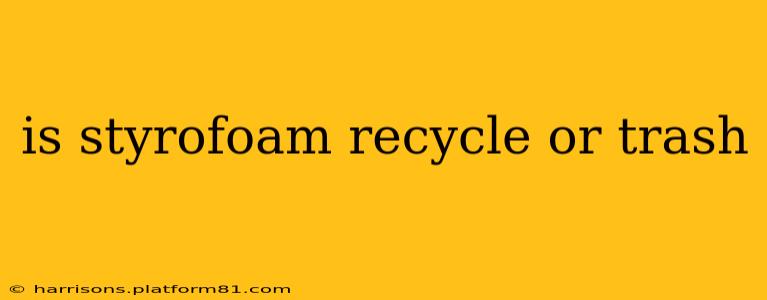Styrofoam, that ubiquitous white packing material, is a source of constant confusion. Is it recyclable? Trash? The answer, unfortunately, isn't a simple yes or no. It depends heavily on your location and the specific type of Styrofoam. Let's delve into the details.
What is Styrofoam?
Before we tackle recyclability, it's crucial to understand what Styrofoam actually is. The term "Styrofoam" is often used generically, but it's actually a brand name owned by Dow Chemical Company. The material it refers to is expanded polystyrene (EPS), a type of plastic. Many other similar expanded plastics are often incorrectly labeled as "Styrofoam," leading to confusion. These include extruded polystyrene (XPS), which is used in insulation, and other expanded plastics.
Is Styrofoam Recyclable? The Complicated Truth
The short answer is: sometimes. Unlike many other plastics, Styrofoam's recycling infrastructure is significantly limited. Many curbside recycling programs do not accept it due to the challenges involved in processing it.
The process of recycling Styrofoam is more complex and energy-intensive than recycling other plastics. It requires specialized facilities equipped to handle its unique properties. It’s often too light and bulky for standard sorting machinery and contaminates other recyclable materials.
Therefore, whether or not you can recycle Styrofoam depends entirely on:
- Your Local Recycling Program: Check your municipality's website or contact your waste management provider directly. Some cities have specific drop-off locations for Styrofoam recycling, while others may participate in larger-scale recycling initiatives.
- The Type of Styrofoam: As mentioned, there are different types of expanded plastics often misidentified as Styrofoam. Ensure you know what you are dealing with to find appropriate recycling options.
Where Can I Recycle Styrofoam?
If your curbside recycling doesn't accept Styrofoam, several other options might be available:
- Specialized Recycling Centers: These facilities specifically handle hard-to-recycle materials like Styrofoam. Search online for "Styrofoam recycling near me" to find locations in your area.
- Retailer Take-Back Programs: Some retailers, like certain grocery chains or big-box stores, may have take-back programs for specific types of Styrofoam packaging. Check with your local stores to see if they offer this service.
- Earth911: This website (earth911.com) is a great resource for finding recycling locations for a wide variety of materials, including Styrofoam.
What Happens to Recycled Styrofoam?
When Styrofoam is successfully recycled, it's typically processed into various products, including:
- Picture frames
- Crown molding
- Packaging peanuts
- Insulation
How Can I Reduce My Styrofoam Use?
The best way to deal with Styrofoam waste is to reduce its use in the first place. Consider these alternatives:
- Choose products with minimal packaging: Opt for items with less packaging or packaging made from recycled materials.
- Reusable containers: Use reusable containers for food storage and leftovers instead of Styrofoam takeout containers.
- Support businesses committed to sustainability: Choose businesses that prioritize eco-friendly packaging options.
Is there a difference between Styrofoam and other types of expanded polystyrene?
Yes, there's a key difference between EPS (expanded polystyrene) and XPS (extruded polystyrene). While both are types of polystyrene foam, they have different densities and structures, leading to varied applications and recyclability. EPS is the lighter, more common type typically used for packaging, while XPS is denser and often used in insulation. Their recyclability can also vary depending on local programs.
Can I compost Styrofoam?
No, Styrofoam is not compostable. It's a plastic that will not break down naturally in a compost pile.
Why isn't Styrofoam widely recycled?
Styrofoam recycling is challenging due to its low density and bulkiness, making it difficult and expensive to transport and process effectively in standard recycling facilities. It often contaminates other recyclables, causing issues in the sorting process. Additionally, the market for recycled Styrofoam is still relatively small.
This guide offers a comprehensive overview of Styrofoam recycling. Remember to always check your local recycling guidelines for the most accurate information and to explore alternatives to reduce your Styrofoam consumption.
